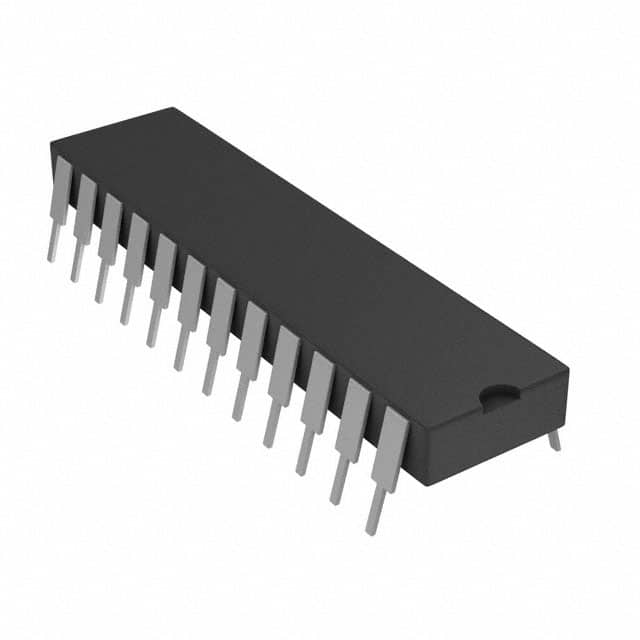CD74HC154E
Product Overview
- Category: Integrated Circuit
- Use: Decoder/Demultiplexer
- Characteristics: High-speed, CMOS logic, 4-to-16 line decoder/demultiplexer
- Package: DIP (Dual In-line Package)
- Essence: Decodes a 4-bit binary input to one of sixteen mutually exclusive outputs
- Packaging/Quantity: Available in tubes or reels, quantity varies by manufacturer
Specifications
- Supply Voltage Range: 2V to 6V
- Input Voltage Range: 0V to VCC
- Output Voltage Range: 0V to VCC
- Maximum Operating Frequency: 25 MHz
- Propagation Delay Time: 15 ns
- Low Power Consumption: 20µA maximum ICC
- Operating Temperature Range: -40°C to +85°C
Pin Configuration
The CD74HC154E has a total of 24 pins. The pin configuration is as follows:
- GND (Ground)
- A0 (Address Input Bit 0)
- A1 (Address Input Bit 1)
- A2 (Address Input Bit 2)
- A3 (Address Input Bit 3)
- E1 (Enable Input 1)
- E2 (Enable Input 2)
- Y0 (Output 0)
- Y1 (Output 1)
- Y2 (Output 2)
- Y3 (Output 3)
- Y4 (Output 4)
- Y5 (Output 5)
- Y6 (Output 6)
- Y7 (Output 7)
- Y8 (Output 8)
- Y9 (Output 9)
- Y10 (Output 10)
- Y11 (Output 11)
- Y12 (Output 12)
- Y13 (Output 13)
- Y14 (Output 14)
- Y15 (Output 15)
- VCC (Positive Power Supply)
Functional Features
- Decodes a 4-bit binary input to one of sixteen mutually exclusive outputs
- Can be used as a decoder or demultiplexer
- High-speed operation with CMOS logic
- Low power consumption
- Wide operating voltage range
- Provides reliable and accurate decoding functionality
Advantages
- Compact and space-saving design
- Versatile usage as both a decoder and demultiplexer
- High-speed operation allows for efficient data processing
- Low power consumption helps conserve energy
- Wide operating voltage range ensures compatibility with various systems
Disadvantages
- Limited number of output lines (16 in this case)
- Propagation delay time may affect real-time applications
- Sensitivity to electrostatic discharge (ESD) requires proper handling precautions
Working Principles
The CD74HC154E operates based on the principle of binary decoding. It takes a 4-bit binary input and decodes it into one of sixteen mutually exclusive outputs. The address inputs (A0-A3) determine which output line is activated, while the enable inputs (E1 and E2) control the overall operation of the device. When the enable inputs are active, the selected output line becomes active, while all other output lines remain inactive.
Detailed Application Field Plans
The CD74HC154E finds applications in various fields where decoding or demultiplexing of signals is required. Some common application areas include:
- Digital communication systems
- Data transmission and reception
- Address decoding in microprocessors
- Memory selection in computer systems
- Signal routing and distribution
- Industrial automation and control systems
- Robotics and embedded systems
Detailed and Complete Alternative Models
- 74HC154: Similar functionality, but operates at a lower voltage range (2V to 5.5V)
- CD4514: 4-to-16 line decoder/demultiplexer with latch function
- SN74LS154: TTL logic version of the 4-to-16 line decoder/demultiplexer
These alternative models offer similar decoding capabilities and can be used as substitutes for the CD74HC154E depending on specific requirements and system compatibility.
Word count: 540 words
Lista 10 Vanliga frågor och svar relaterade till tillämpningen av CD74HC154E i tekniska lösningar
Sure! Here are 10 common questions and answers related to the application of CD74HC154E in technical solutions:
Q: What is CD74HC154E? A: CD74HC154E is a 4-to-16 line decoder/demultiplexer integrated circuit (IC) commonly used in digital electronics.
Q: What is the purpose of CD74HC154E? A: CD74HC154E is used to decode a binary input and select one of the 16 output lines based on the input value.
Q: What voltage levels does CD74HC154E support? A: CD74HC154E supports a wide range of voltage levels, typically from 2V to 6V.
Q: How many inputs does CD74HC154E have? A: CD74HC154E has 4 binary inputs (A0, A1, A2, A3) that determine the selected output line.
Q: How many output lines does CD74HC154E have? A: CD74HC154E has 16 output lines (Y0-Y15) that can be individually selected based on the input values.
Q: Can CD74HC154E be cascaded to increase the number of output lines? A: Yes, multiple CD74HC154E ICs can be cascaded together to increase the number of output lines.
Q: What is the maximum frequency at which CD74HC154E can operate? A: CD74HC154E can typically operate at frequencies up to 50 MHz.
Q: Does CD74HC154E have any built-in protection features? A: CD74HC154E has built-in diode clamps on all inputs to protect against electrostatic discharge (ESD) damage.
Q: Can CD74HC154E be used in both digital and analog applications? A: No, CD74HC154E is specifically designed for digital applications and should not be used in analog circuits.
Q: What are some common applications of CD74HC154E? A: CD74HC154E is commonly used in address decoding, memory selection, data routing, and other digital multiplexing applications.
Please note that these answers are general and may vary depending on specific datasheet specifications and application requirements.


